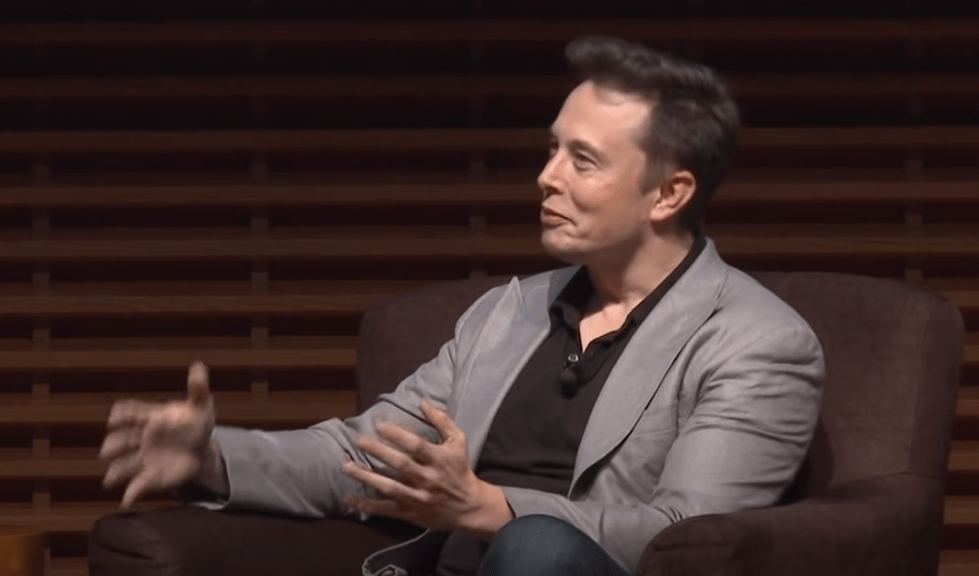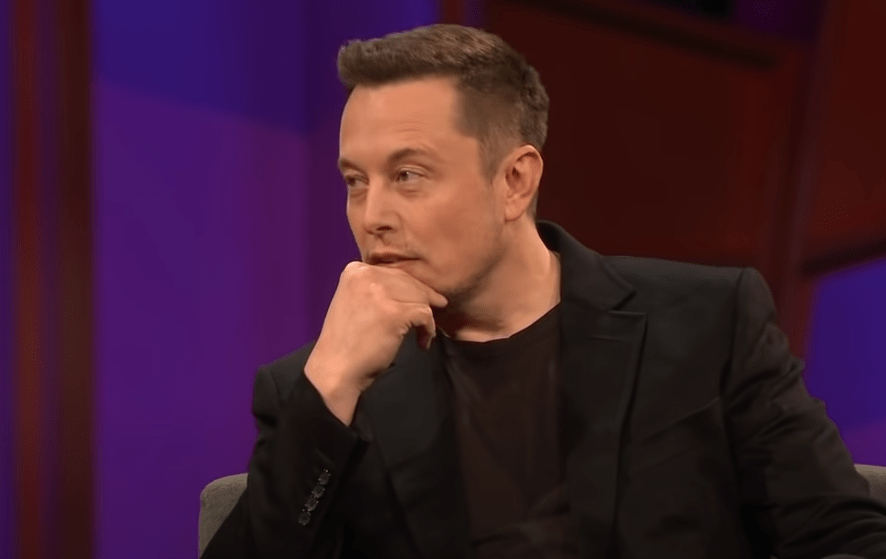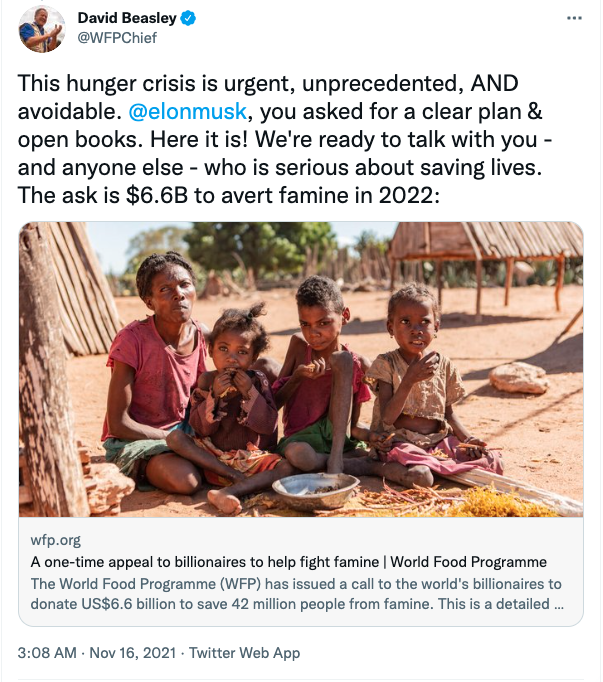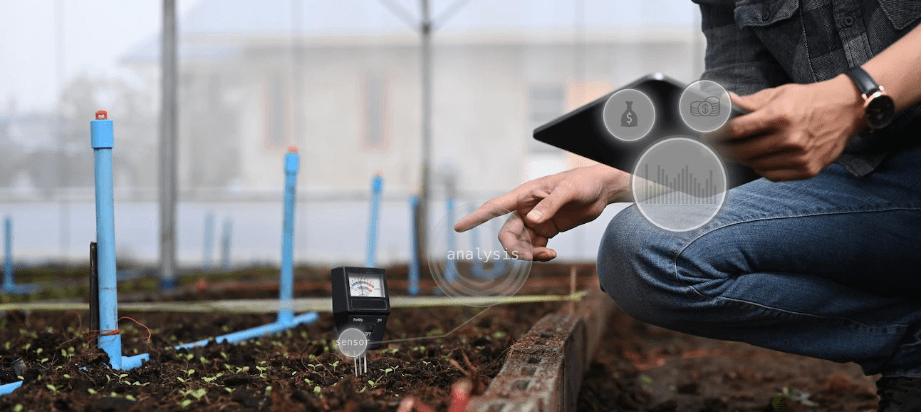Elon Musk’s $6 billion might help feed millions of people who are on the edge of hunger. Following Elon Musk’s Twitter battle with the World Food Program’s president, headlines have been made all over the world. In October, U.N. food agency director David Beasley put out a satirical tweet in honor of Musk’s stated $36 billion days. He wrote, “1/6 of your one-day rise would rescue 42 million lives on the edge of Starvation.”

“If WFP can explain precisely how $6 billion would eradicate world hunger in this Twitter thread, I will sell Tesla shares right now and do it,” Musk tweeted later.
Beasley invited Musk to meet “anywhere Earth or space” to discuss the potential contribution, although Musk quickly emphasized that his earlier tweet was about feeding “those on the edge of starvation” rather than ending world hunger. So yet, Musk hasn’t made any firm commitments to the organization. How big of a difference will $6 billion make in terms of resources when it comes to feeding millions? Despite the World Food Program (WFP) raising $8.4 billion last year, the global food situation continues to worsen.
Based on Musk and Beasley’s Twitter discussion, there are now 45 million people in danger of famine, and the World Food Programme estimates that assisting them will cost $7 billion. “At the same time, millions of people all around the world are facing impending catastrophe. Conflict, climate change, and COVID-19 are all contributing to an increase in acute hunger, according to Beasley. We reached out to experts in humanitarian aid and global hunger to get their take on the $6 billion debate.
Donors Enquire about the Specifics of the initiative
Was Musk correct in questioning the World Food Programme about how the $6 billion will be spent? So it looks, according to the experts we spoke with. Musk is justified in expecting WFP to have a strategy for deploying the money, according to Ian Mitchell, a senior fellow at the Center for Global Development. International organizations should have a plan in place for how they will achieve their objectives.
WFP can show convincing evidence of its prior performance: The World Food Program (WFP), which will receive the Nobel Peace Prize in 2020 for its work, could provide a full solution to Musk’s inquiry. “What WFP does and is good at dealing with famines,” says Steve Wiggins, a research fellow at the Overseas Development Institute in London who specializes in humanitarian affairs, in the case of a food crisis. Last year, the World Food Program (WFP) provided assistance to almost 115.5 million people in 84 countries. The World Food Program (WFP) deployed a fleet of 5,600 trucks, 30 ships, and 100 planes to transport food, laborers, and others needed for the operation.
With a 60-year track record of delivering relief, the organization is able to reach some of the world’s most isolated regions. In a report released in May, Wiggins and Simon Levine of the Overseas Development Institute looked at what has been done to help persons impacted by the longest-running wars over the previous three decades. The World Food Programme, according to their results, did make a difference in these cases, but only to a degree. “The troubling element is that so little was done,” says Levine, “but when there was emergency help, it was mostly in the form of food aid from the World Food Program.”
In their study, the scientists wrote, “This help probably protected users from excruciating agony.”

What would be able to acquire with $6 billion, Exactly?
Musk demanded further details, to which Beasley replied with the following math: “$.43 x 42,000,000 = $6.6 billion.” According to the World Food Program, one meal a day for a year would cost that much (WFP). The organization would distribute food aid, cash, or vouchers as a “meal.” According to the World Food Program, rice, maize, and high-energy biscuits are among the commodities included in food distribution.
Food aid, on the other hand, encompasses more than simply food donations; it also involves training and education programs. It’s vital to remember that 43 cents per person per year isn’t just the cost of one meal per day, as Levine points out. According to him, the WFP’s per capita estimate is all that is required to carry out this activity. In addition to the actual food, cash, or vouchers, the cost of ensuring that the assistance reaches the people that need it most and monitoring its distribution to ensure that the money is spent properly would almost certainly be included.
There is, however, another way to spend the $6 billion: Indeed, some experts feel that offering temporary relief should be phased out entirely. “WFP claims they hope to feed 42 million with a meal a day for 365 days,” says a professor, director, and head of the African Research Universities Alliance’s Centre of Excellence in Food Security at the University of Pretoria (South Africa). According to Sibanda, providing assistance may cause countries to grow overly reliant on it. According to her, large donations should instead go toward long-term solutions that address the root causes of famine and hunger, such as teaching farmers better techniques, encouraging the average person to grow nutrient-dense crops for themselves and to sell, and ensuring countries have a stronger social safety net to meet food needs in times of crisis.
Changes to the system as a whole would cost at least $6 billion more than the $8.4 billion raised by the WFP last year. Governments throughout the globe spend more than $100 billion a year to combat extreme poverty and hunger, but Mitchell says, “everyone believes it’s nowhere near what we need to solve this problem.” When you look at the data in this way, Mitchell argues, you realize what you’ve been missing: “what the world’s poorest people make on a daily basis.” The difference between death and life might be as small as fifty cents a day.”
In any case, $6 billion would be Enormously Beneficial
Despite differences in opinion on the best ways to help folks on the edge of famine, our sources all feel Musk’s $6 billion gifts will be tremendously useful. For starters, it’s a substantial sum of money. If aimed toward the world’s poorest and hungry, Mitchel believes a one-time gift of $6 billion would be “a very large charitable contribution, maybe one of the greatest ever” and “would certainly provide the greatest effect to human welfare.”

Now, according to Levine, it would be ideal if more millionaires could jump on board. If Jeff Bezos gave another $6 billion, bringing the total to $12 billion, we could do twice as much. On CNN, Beasley indicated that the $6 billion was only needed once, but that if the fundamental causes of global poverty and hunger aren’t addressed, the WFP will plead for more money in the future. The UN’s Beasley called on the world’s wealthiest individuals to give $5 billion to the World Food Programme during the COVID-19 outbreak, which they did. According to the World Food Program, more people were on the verge of starvation during the outbreak, and billionaires’ net worth increased (WFP).
The World Food Programme (WFP), which publishes annual audited financial reports, has historically been questioned about its performance. In its 2018 study, the non-profit Center for Global Development (CGD) ranked the World Food Programme (WFP) as the 40th least successful aid organization. WFP was dropped from this year’s rankings by CGD, which changed its methodology to exclude humanitarian aid from most of its calculations. The World Food Programme was kept off the list because it focuses on “humanitarian” rather than “developmental” investment.




